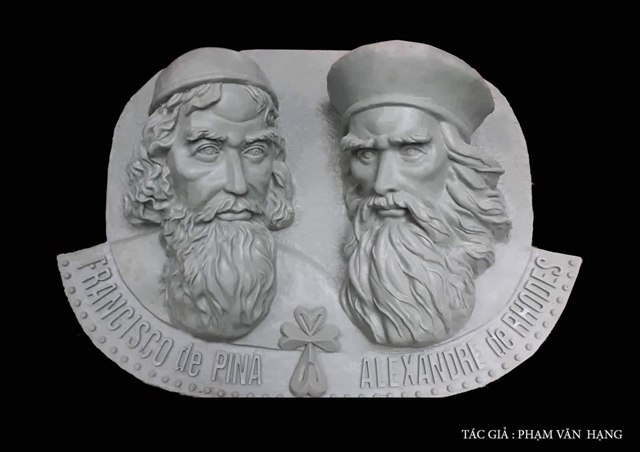
The design of a monument honouring Portuguese missionary Francisco de Pina (1585-1625) – the founder of the modern writing system of the Romanised Vietnamese script – which is to be installed in Guarda City, Portugal on November 26. Photo courtesy of Nguyễn Bích Thủy
QUẢNG NAM — The inauguration of a monument honouring Portuguese missionary Francisco de Pina (1585-1625) – the founder of the modern writing system of the Romanised Vietnamese script – will be held in Guarda City, Portugal on Sunday.
Secretary of the ‘Chữ Quốc Ngữ’ (national Romanised Vietnamese script) Foundation, Nguyễn Bích Thủy said the copper-cast monument was made by artisans in the craft village of Phước Kiều in the central province of Quảng Nam.
She said the symbol was being shipped to Guarda City for installation at the Eduardo Lourenco Library Park in Guarda City.

Craftsmen from Phước Kiều village cast a bronze monument in honour of Portuguese missionary Francisco de Pina. The symbol was being shipped to Portugal for its inauguration ceremony in late November. — Photo courtesy of Nguyễn Bích Thủy
Thủy said work on the monument began on December 15th, 2020 – the day that Francisco de Pina died in waters off Hội An 395 years ago.
The upper part of the monument was designed based on a vessel Francisco de Pina used to travel Việt Nam in the 16th century, while the lower part was decorated with patterns of Đông Sơn Culture bronze drums.
She said a delegation from the foundation, donors and overseas Vietnamese living in the European Union would participate in the monument inauguration ceremony.
According to Professor Nguyễn Đăng Hưng from University of Liège, in Belgium, the foundation’s members had two visits to Guarda City for the proposal of installing the monument honouring the founder of today’s Romanised Vietnamese script.
Hưng, who is President of the foundation, said the authority of Guarda City approved the proposal and the monument will be set up in the hometown of Francisco de Pina.
He said de Pina was born in Guarada, a remote area in the north of Portugal, and joined the Jesuit order at the age of 19. The Portuguese was then sent to Hội An in 1617.

The design of a sculpture of Francisco de Pina (left) and Alexandre De Rhodes, created by sculptor Phạm Văn Hạng. — Photo courtesy of Phạm Văn Hạng
Hưng said de Pina was the only western missionary who spoke Vietnamese fluently when he came to Hội An, and he could preach to local people without an interpreter.
The priest then set up the first school at Thanh Chiêm for teaching Vietnamese Romanised script and religious education in 1619, Hưng said, adding the church and school was built in 1623.
Hưng explained that the creation of the Romanised Vietnamese script helped many Vietnamese people learn to read and write more easily.
According to an old document, de Pina drowned in 1625 after a hurricane hit the sea off Hội An when he and his assistants were on board a small boat bringing documents to a larger Portuguese vessel.
The central Quảng Nam Province has been planning a restoration of the defunct Thanh Chiêm Palace (1602-1883) – a cradle of the Romanised Vietnamese script in linkage with Francisco de Pina, and then his student French missionary Alexandre de Rhodes (1591-1660).
At a scientific workshop on the Romanised Vietnamese script, researchers said there were three tombs where missionary priests had been buried in the André Phú Yên church’s graveyard in Điện Bàn town.
Priest Joseph Nguyễn Thanh Tùng, who now manages André Phú Yên Church, said Jesuit priests were often laid to rest at the church when they passed away.
Priest Tùng said while removing three ancient tombs at Church, workers found European designed wooden coffins and big bones that would indicate burial 400 years ago.
Some suspect that one of ancient tombs was the resting place of Francisco de Pina.

André Phú Yên Church in Điện Bàn town of Quảng Nam Province still preserves three tombs of the former Western missionaries. They helped introduce the Romanised Vietnamese script from 16th century. — VNS Photo Công Thành
“The old documents revealed priest Francisco de Pina had lived in the church for missionary work, and taught Romanised Vietnamese script at the nearby Thanh Chiêm Palace,” according to Priest Tùng.
De Rhodes completed a Portuguese-Vietnamese-Latin dictionary that used material from de Pina’s dictionary, which helped make it possible to translate Vietnamese into Russian, French, Italian and Japanese, Hưng said.
He added the introduction of Romanised Vietnamese script was also contributed by the others from Europe as well.
In 2018, representatives of the foundation also set up a statue in honour of French missionary Alexandre de Rhodes at Isfahan, Iran. VNS
OVietnam